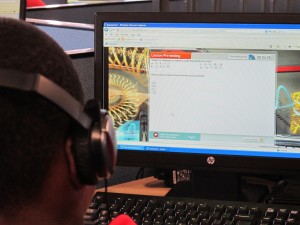Does It Matter That Most 'MOOC' Students Drop The Online Courses?
Supporters of massive open online courses or “MOOCs” say the free, online, open-to-anyone classes are just the sort of “disruptive innovation” higher ed needs.
Indiana University has committed $8 million for a “major strategic investment in online education” to develop MOOCs of its own.
Skeptics aren’t convinced, pointing to the large numbers of students who drop the course before it’s over. But Stanford mathematician Keith Devlin — who leads a MOOC — writes in The Huffington Post it’s not fair to point to attrition rates as a weakness unique to MOOCs:
The equivalent figure for my own university, Stanford, is 95 percent. That’s right, 95 percent; a higher attrition rate than my online course. That’s not Stanford’s published “graduation rate,” of course. Of students admitted, 79 percent graduate in four years and 96 percent within six. But that’s comparing apples with oranges. Anyone who decides to take a MOOC simply logs onto the website and signs up, thereby becoming one of the statistics.
So a fair comparison would be to take the number of students who apply to Stanford. That figure is around 35,000, by chance about the number of students I expect will sign on for my course. So considerably more students who sign up for my free online course will graduate than will occur with students who “sign up” (i.e., apply) to Stanford, which graduates about 1,700 students a year.
The (only) point I am trying to make with this comparison (which has numerical significance, but says nothing about quality of education or utility), is that applying the traditional metrics of higher education to MOOCs is entirely misleading. MOOCs are a very different kind of educational package, and they need different metrics — metrics that we do not yet know how to construct.
Education writer Annie Murphy Paul blogs:
I’m sorry, Professor Devlin, but that comparison just doesn’t hold up. Students apply to a traditional college hoping to be admitted; they almost always apply to several other colleges, and they certainly don’t intend to be a student at all of them. Someone who signs up for a MOOC is signaling an intention to learn from that particular course, and if they drop out, that carries a different meaning from not being admitted to or not accepting admission at a traditional college.
Here’s more on IU’s “strategic investment” in MOOCs from university president Michael McRobbie’s State of the University speech:
IU Online, then, is how IU intends to “project” itself beyond the walls of the campuses, and equally importantly, the walls of the classroom in the 21st century. It recognizes that the distinction between “traditional” and “non-traditional” students is increasingly blurred and that it no longer makes sense to use different strategies to reach them. It recognizes that all the online courses and degrees must be owned by the schools and campuses as online education is becoming an increasingly fundamental and integral part of what they do.
However, as we vigorously move forward with IU Online, we must nevertheless also maintain a skeptical and questioning approach—as is appropriate for a university—to some of the wilder claims being made about online education.
What are your thoughts on MOOCs? Shiny new toy? Substantive, disruptive innovation? How do you measure success for a massive open online course? And how should universities and students use them? Tell us in the comments section.

